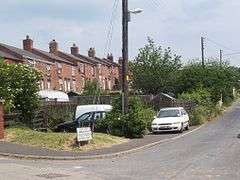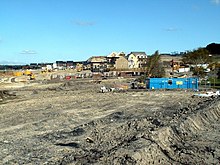Woolley Colliery
Woolley Colliery is a village on the border between the Barnsley and Wakefield districts in Yorkshire, England. The village is in South Yorkshire whilst the former colliery was situated in West Yorkshire in the Wakefield Rural Ward. The village is known locally as Mucky Woolley, a tribute to its coal mining heritage and to distinguish it from the more affluent village of Woolley situated two miles away.
| Woolley Colliery | |
|---|---|
 A row of terrace houses in Woolley Colliery | |
 Woolley Colliery Location within South Yorkshire | |
| OS grid reference | SE319132 |
| Metropolitan borough | |
| Metropolitan county | |
| Region | |
| Country | England |
| Sovereign state | United Kingdom |
| Post town | BARNSLEY |
| Postcode district | S75 |
| Dialling code | 01226 |
| Police | South Yorkshire |
| Fire | South Yorkshire |
| Ambulance | Yorkshire |
| UK Parliament | |
Coal mines were worked as early as 1850, and at about that time the village was established when two rows of small terrace cottages were built to accommodate the miners. There are several coal seam outcrops on the hillside and coal was probably mined in that area for many years before that, but only on a small scale until railway transport began. The pit grew to become one of the largest in West Yorkshire; in 1980, it employed 1514 men underground and 428 on the surface.
The colliery began as when two tunnels or drifts were dug into the hillside into the Barnsley bed seam. Vertical shafts were sunk to reach the deeper seams. In the 1960s there were three shafts in the pit yard and a fourth, for ventilation, about a mile to the east. At that time around 17,000 tons of high quality coal was produced each week.
The NUM leader, Arthur Scargill, started work at the colliery in 1953 aged 15. The pit was traditionally amongst the most conservative in Yorkshire, and Scargill was often in dispute with the branch leadership. He organised a strike in 1960 over the day on which union meetings were held, as he argued that these were deliberately held at a time when the sections of the workforce that were inclined towards militancy were unable to attend.[1]
Miner's Strike 1984-85
During the UK miners' strike (1984-85), roughly 70% of the workforce struck for a year,[2] but the NUM branch leadership remained conservative on the use of flying pickets and union funds to help strikers.[3][4] There were arguments with the lodge at North Gawber Colliery on contributions to a kitchen, as it was claimed that Woolley (which was a much larger pit) was making a minimal contribution to feeding strikers.[4] After the strike the men from North Gawber were transferred to Woolley.
Woolley Grange

The pit closed in 1987 and was demolished in 1993. The site is now home to a private housing estate, Woolley Grange.[5]
References
- Routledge, Paul (1994). Scargill: the unauthorized biography. London: Harper Collins. pp. 31–33. ISBN 0-00-638077-8.
- Winterton, Jonathan; Winterton, Ruth. Coal, Crisis, and Conflict: The 1984–85 Miners' Strike in Yorkshire. Manchester University Press. p. 222. ISBN 9780719025488.
- Winterton, Jonathan; Winterton, Ruth. Coal, Crisis, and Conflict: The 1984–85 Miners' Strike in Yorkshire. Manchester University Press. p. 101. ISBN 9780719025488.
- Winterton, Jonathan; Winterton, Ruth. Coal, Crisis, and Conflict: The 1984–85 Miners' Strike in Yorkshire. Manchester University Press. pp. 123–4. ISBN 9780719025488.
- "Woolley Grange Residents Association - Woolley Colliery History", Woolley Colliery History, accessed November 2018
External links
| Wikimedia Commons has media related to Woolley Colliery. |